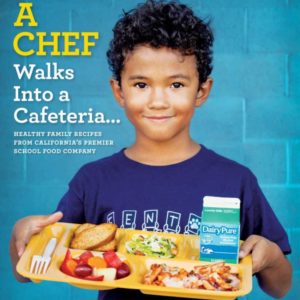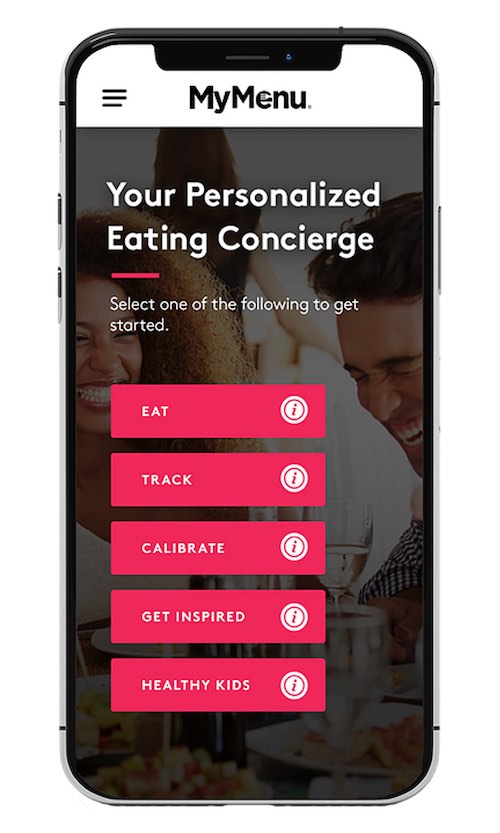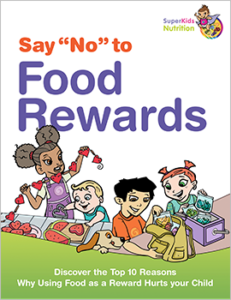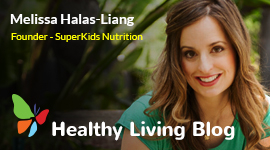
Learn how you can feed your kids healthier foods and the importance of school lunch.
At Superkids Nutrition we’re always here to help your kids’ nutrition with healthy meal ideas! We were lucky enough to catch up with Emily Burson, RD about her new book A Chef Walks Into a Cafeteria. The book pays homage to her company School Nutrition Plus (SNP) who serves scratch-based meals to schools across Southern California. Full of beautiful, delicious and healthy dishes, her book showcases the successful recipes that have been crafted by the SNP chefs and have received her nutritional stamp of approval. Emily has a passion for educating children about healthy food through positive food experiences with school meals. Her book strives to impart her scratch-cooking method on parents to utilize with their children at home. Below we picked her brain about school lunch and strategies parents can utilize to get their kids to eat more fruits and vegetables!
What’s your favorite aspect of your book that parents and kids will benefit from the most?
The goal of the book is to expose kids to the movement of scratch-cooked food in schools. When parents and kids cook together from the book, the recipes become more familiar and kids are more likely to make healthy choices in school and when eating out in general.
Why should every parent care about school nutrition, even if they pack their kids’ lunch?
The school food industry is currently a large consumer of processed foods and factory-farmed meats. By supporting the movement towards real food in schools, parents are having a positive impact on the local and healthy food industries.
What are some unique components about your program?
We are chef and dietitian driven, in that the menu is developed based on flavors and nutrition within the National School Lunch Program regulations. It’s hard to impart flavor without salt, but our chefs know how to elevate dishes even with the sodium restrictions. We also hold nutrition education events at all of our schools to complement the meals we serve. One example is the Alphabet Produce Train. Here, we offer composed salads containing produce from A to Z and display them in a train model designed by an entertainment industry set designer.
What is your favorite recipe in the book and why?
My favorite recipe is the Quinoa Cranberry Almond Granola. It’s so versatile and shows up on our menus at breakfast, lunch, special events and is our annual holiday gift to clients. I love the nutty crunch from the toasted quinoa and we can easily substitute seeds for nuts in the case of food allergies without compromising flavor.
This dish proves that a simple cooking technique can turn a few ordinary ingredients into a beautiful and utterly delicious dish. Inspired by some leftover quinoa from an Alphabet Produce Train (APT) event, Chef Louis created this granola to give as homemade gifts for our school clients and vendors. Toasting the grains, nuts, and seeds enhances the nutty flavor and gives the granola a crisp texture.
Makes 12 servings
Ingredients:
- 1 cup lightly packed brown sugar
- 1/3 cup water
- 4 cups old-fashioned rolled oats
- 2 cups uncooked quinoa
- 2 cups sweetened shredded coconut cups
- ½ cup roasted and unsalted sunflower seeds
- 1 ½ cups chopped almonds
- 1 teaspoon ground cinnamon
- 1 teaspoon ground nutmeg
- ¾ teaspoon kosher salt
- 1/3 cup canola oil
- 2 ½ teaspoons vanilla extract
- 1 cup sweetened dried cranberries
Directions:
- Preheat the oven to 350°F. In a small saucepan, combine the brown sugar and cup water and cook over medium-high heat, stirring constantly, until the sugar is completely dissolved and the mixture comes to a boil (about 3 minutes). Remove the saucepan from the heat and let the syrup cool slightly.
- In a large bowl, toss the oats with the quinoa, coconut, sunflower seeds, almonds, cinnamon, nutmeg, and salt.
- Add the canola oil and vanilla to the brown sugar syrup and whisk well.
- Pour the syrup over the oat mixture and mix well with a rubber spatula or your hands until thoroughly combined.
- Transfer the oat mixture to a baking sheet and pat it down to an even layer; it will be thick but shouldn’t rise above the rim of the baking sheet.
- Bake, stirring every 10 minutes with a spatula, until the mixture turns a nice even, golden brown – about 45 to 55 minutes. Watch granola carefully because coconut burns easily!
- Remove the granola from the oven and cool, stirring occasionally.
- Add dried cranberries when granola is cool, and store in an airtight container.
Make it ahead: Store granola in jars covered with lids that make an airtight seal for up to one week. You can also spoon granola in decorative jars to give as gifts.
Do you think your program could be implemented on a larger scale in schools across the country?
Absolutely! With a chef and proper equipment, every school district can make food from scratch. Obviously, there’s a transition period, but there are equipment grants offered every year and chefs are trained on how to prepare food cost-effectively and efficiently. It may seem like a large hurdle to a lot of school districts, but taking small steps, like adding one new menu item per month, is realistic and is better than no action at all.
With the guidelines set forth by the Healthy, Hunger-Free Kids Act (HHFKA) do you feel most schools are adequately meeting the guidelines?
I think that schools are meeting the guidelines, but not the spirit of the Act. The goal of the Act was to get kids to eat more produce, whole grains and less sodium, which is great in theory, but practical aspects weren’t taken into consideration. Students have as little as 25 minutes to go through a lunch line and eat, and this just isn’t enough time to make a dent in the increased amount of food that we need to serve. Thus, a lot is going in the trash. With the whole grain regulation and resulting elimination of white rice and flour tortillas, we’re communicating to certain cultures that staples of their diet are unhealthy, which just isn’t true. These foods in moderation are fine. I just got back from a trip to Taiwan where I was consulting with a school that has rice on the menu daily. Child obesity isn’t a problem in this region because students are taught moderation and balance, and nutrition and physical activity are emphasized in the curriculum and at home. I had a chance to create nutrition guidelines for this school and took the approach of softening the Act while combining cultural preferences. In my wildest dreams, the USDA would ask me to help revise theirs.
In your opinion, what is the most challenging aspect (biggest hurdle) that schools face in providing healthier options to students?
Meeting the USDA regulations considering that the Federal and State reimbursement for meals often isn’t enough to cover labor and food costs.
What is an action parents can take to advocate for better school meals and get more programs like SNP at their child’s school?
Parents are often the biggest drivers of change in schools. Every school is required to have a Wellness Committee, so I recommend joining this and being as active as possible. I have seen many PTA groups take on food service as a project, whether it’s fundraising to supplement the food service budget, or providing feedback to the administration.
What do you see as the biggest benefit to the students who receive your meals made from scratch?
The lunchroom is a classroom, and we are exposing students to nutritious food that they may not get at home. Thus, we are training their minds and palates to make healthy choices for a lifetime.
Do you find that students are more engaged with their food when they are trying foods from different cultures?
Students are engaged when adults and other role models are engaging them and modeling healthy choices, regardless of the type of cuisine. Sometimes all it takes is a principal eating a piece of fruit in front of the students for them to try it, when otherwise, it would go in the trash. This is a great example of my comment above about treating the lunchroom as a classroom.
What steps can parents take to make more meals at home from scratch?
Planning is key because we know it’s not practical to start grocery shopping at 5:00 p.m. Do your shopping on the weekends and plan menus for the week!
What are some strategies you and the SNP chefs use to increase fruit and vegetable consumption among the students?
One surefire way to get our students to eat fruits and vegetables is to cut them. Orange wedges vs a whole orange, or sliced kiwi vs. whole.
Which recipes from your book are the most popular with the students at the schools you serve?
Hands down the Herb Roasted Chicken Drumsticks. Students clean their plates when this is on the menu.
What tips can you give busy parents who are trying to maximize their child’s nutrition?
Be a role model. Kids can’t be expected to make healthy choices if the adults in their lives aren’t.
More about the author:
 Emily Burson, RD, Founder & President of School Nutrition Plus has been pushing the envelope of school dining since 2009. After managing school kitchens where the definition of cooking meant opening a box of frozen food and putting it in the oven, Emily’s relentless desire to serve kids real food and teach them where it comes from drove her to start SNP. Having worked with professionally trained chefs, she is widely recognized for leading culinary teams and is responsible for the overall direction of SNP, which employs more than 100 team members. One of Emily’s greatest joys is tasting the creative food that the chefs at SNP come up with while working within tight budget and nutrition constraints. This past spring, Emily alongside her business partner and SNP’s executive chef, Brandon Neumen launched a cookbook, A Chef Walks into a Cafeteria...to honor the flavor values of scratch cooking and inspire families to cook together…with recipes actually served in the school cafeteria! You can follow Emily on Instagram & Twitter: @emilyburson_rd
Emily Burson, RD, Founder & President of School Nutrition Plus has been pushing the envelope of school dining since 2009. After managing school kitchens where the definition of cooking meant opening a box of frozen food and putting it in the oven, Emily’s relentless desire to serve kids real food and teach them where it comes from drove her to start SNP. Having worked with professionally trained chefs, she is widely recognized for leading culinary teams and is responsible for the overall direction of SNP, which employs more than 100 team members. One of Emily’s greatest joys is tasting the creative food that the chefs at SNP come up with while working within tight budget and nutrition constraints. This past spring, Emily alongside her business partner and SNP’s executive chef, Brandon Neumen launched a cookbook, A Chef Walks into a Cafeteria...to honor the flavor values of scratch cooking and inspire families to cook together…with recipes actually served in the school cafeteria! You can follow Emily on Instagram & Twitter: @emilyburson_rd












